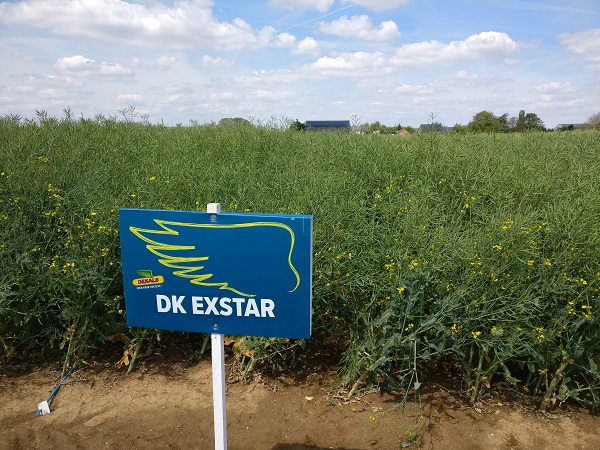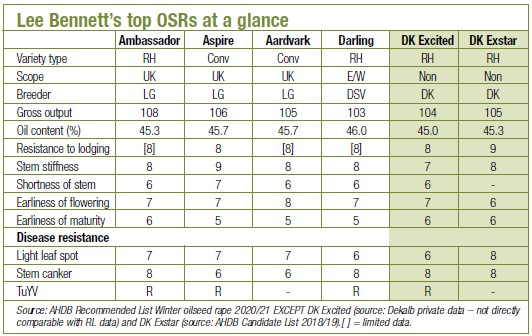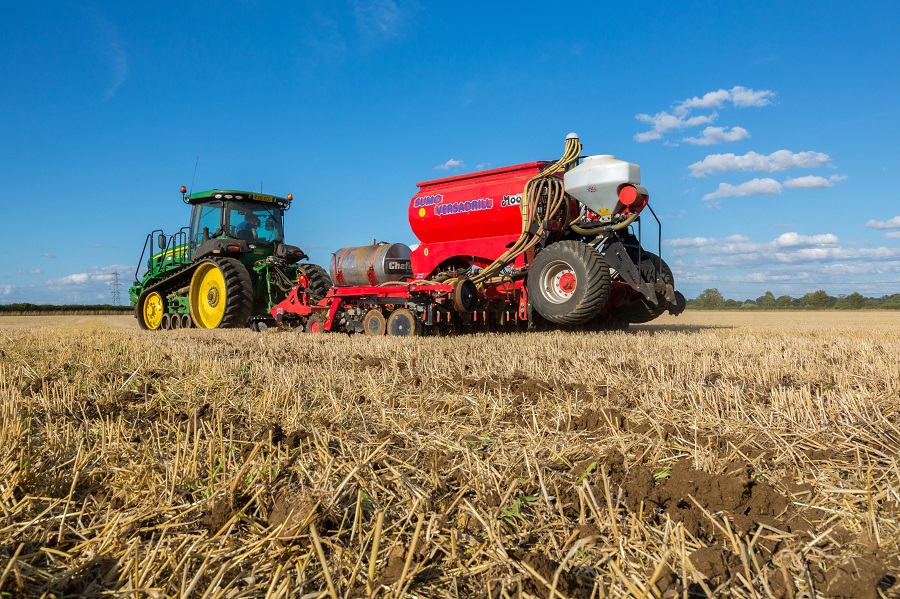For many oilseed rape growers, vigorous growth to stay one step ahead of cabbage stem flea beetle comes squarely at the top of their list of requirements. CPM seeks a steer on which varieties will deliver this.
This variety hits the ground growing and it’s super vigorous.
By Tom Allen-Stevens
When CPM published its first Variety Labs in June 2013, asking an industry expert to pick their top six oilseed rape varieties, the key consideration was whether it was a hybrid or conventional type. Speed of development got a down-page mention and few growers even considered cabbage stem flea beetle (CSFB).
How times have changed. Priorities have too – for many growers, it’s not so much a question of how much the crop will fill the combine header as whether it’ll actually ever reach it. Breeders are keenly conscious of this perilous state of the nation’s OSR crop and have been busting a gut to bring you beetle-beating, virus-thwarting varieties that will zing out of the ground and ensure you were thankful you stuck with this much maligned crop.
So which ones have the best prospects of doing exactly that? CPM asked Openfield’s Lee Bennett to pick his top six varieties for drilling this autumn.
Ambassador
Leading the hybrids on the AHDB Recommended List is newcomer Ambassador, which the first of Lee’s top six. “It has the highest gross output of the hybrids with a stiff stem and wants to get on with flowering,” he says.
“Ambassador combines a good light leaf spot score with the Rlm7 gene for stem canker, pod shatter and turnip yellows virus (TuYV) resistance. But what sets this one apart is the N-Flex trait, designed to give you more flexibility in how you apply nitrogen. The data is compelling and if this rings true in the field it’ll prove valuable for those crops that come out of winter like chicks and hens.”
Limagrain’s Liam Wilkinson points out that Ambassador is the first four-trait hybrid variety in the market, with the addition of its N Flex trait. “The variety shows exceptional autumn and spring vigour and has a very good disease resistance profile,” he adds. See CPM April issue p63 for more insight.
Aspire
This variety’s very much “in vogue” says Lee. “It has the gross output you need and it’s early to flower – that always gives you an indication of its vigour in the spring and a reliable pointer that it will build canopy.
“With a 7 for LLS, it’s the only conventional on the RL with TuYV resistance. My only concern is that it’s a determinate variety and its speed of development is slightly slower than some of the other list leaders. But if you’re planning to drill early, this is the one to go for.”
Liam adds that this high yielding conventional variety is a very robust plant type with short stiff stems, making it well suited for earlier drilling windows. See Insiders View, CPM April issue p39 for more.
Aardvark
“I like this one – it’s the best conventional we’ve ever handled,” says Lee.
“There’s a generous gross output, with plenty of oil on top of stiff straw and it’s as early to flower as you’ll get in a conventional – all pointing to a voluptuous canopy. Its speed of development is good in both autumn and spring – this is the conventional that thinks it’s a hybrid.”
Liam notes Aardvark’s good disease profile and strong agronomic package. “It’s a robust and adaptable variety and demonstrates high yield performance in all areas of the UK and with an early maturity which can be of benefit to some growers,” he adds.
Darling
True to its name, Darling has been one of Lee’s favourite varieties since he first saw it before it even became an RL Candidate variety. “It’s always looked one of the best in trial plots and its performance has always come true,” he says.
“It’s stuffed full of all the traits you need – pod shatter, TuYV and Rlm7 for phoma resistance. But the best bit for me is Darling’s growth habit – this variety hits the ground growing and it’s super vigorous, which puts it in a class all of its own.”
Darling is what DSV’s Sarah Hawthorne calls a ‘triple-layer’ variety combining high gross outputs with the three traits, aiming to deliver simple maintenance and low growing costs.
“These have been developed in response to the demands faced by growers. With an 8 for phoma stem canker and 6 for LLS resistances, it’s got high performance potential and real-world resilience built-in.”

If you’re worried about standing power, just grow DK Exstar.
DK Excited
“It’s the Dekalb hybrid other breeders are worried about,” says Lee. “This is a universally adaptable variety that’ll grow wherever it’s put, and the clue’s in the name – it’s new and exciting.
“This will be its first commercial year in the UK, but it’s been coming top in trials. It has Extrovert-like maturity and growth habit with stiff straw and not too tall, quick into flower – it’s the new kid on the block.”
One of the first two Dekalb varieties to carry TuYV resistance, that puts the trait into a trusted and robust background, says Bayer’s Richard Phillips. “As well as all the normal things you’d expect from an Ex variety (vigorous establishment, double phoma resistance, solid LLS resistance, good standing power and pod shatter resistance) it’s ultra-rapid – one of the fastest varieties of all to develop in the autumn.”
DK Exstar
This is the variety that’s the precursor to Excited. “It was an RL Candidate that unfortunately didn’t make it on to the List because of supply chain issues, but it has a high gross output with super stiff straw – you don’t often see a 9 on a hybrid,” notes Lee.
“There’s no TuYV resistance, but this is a beautiful variety – if you’re worried about standing power, just grow DK Exstar.”
Dekalb breeder Matthew Clarke considers this to be the best all-round variety he’s ever bred. “It’s the first to deliver solid 8 or higher ratings for phoma resistance, LLS resistance, lodging resistance and stem stiffness and it’s classed as rapid in its autumn development,” he says.
“DK Exstar is the natural successor to grower favourites, DK Extrovert and DK Exalte with a higher output and better agronomic package than either.” See Insiders View, CPM May issue p28 for more.

Eight ways to battle the beetle
An integrated approach to controlling cabbage stem flea beetle (CSFB) is vital says Agrii seed technical specialist David Leaper.
“This year, there’s less appetite to plant OSR after two particularly difficult years with dry conditions at drilling and losses to both the adult and larvae stages of. But it remains a useful and profitable break crop if it’s established and grown successfully.”
Agrii has devised an eight-point plan to help growers ensure success with OSR establishment this autumn.
Rotation, rotation, rotation
Close rotations are the cause of many problems in OSR, he says. “These have been much closer in the UK than anywhere else in Europe. They’re now broadening out and once every five years is a good target, although there are benefits from going wider still.”
CSFB is relatively mobile, David explains, easily moving between adjacent fields. “Sacrificial field boundaries, such as turnip rape on headlands, leaving OSR volunteers in neighbouring fields or block cropping to improve isolation are all measures that are used to try to divert the pest from the new crop.”
Green lean
Adult CSFB are attracted by the green leaves of the young OSR crop against bare soil, he notes. “Drilling into tall straw or into green cover can significantly reduce the effects of adult feeding damage by effectively camouflaging the crop.” Nurse crops, such as rye and vetch or crimson and berseem clover, can also be considered.
Moisture must
While early drilled crops establish better, they often carry higher larval numbers into late autumn and the spring. “Meanwhile delayed drilling until after the peak migration is possible but very high risk as soil conditions normally decline quickly in Sept.
“The most important factor is having adequate seedbed moisture so that seedlings are actively growing by the time of migration. Calendar date is less important.”
Fastest first
David points to significant differences in growth rate of varieties over the autumn period and their ability to grow away vigorously in the spring – Agrii research suggests there’s a 30% difference between slowest and fastest varieties and a 10% difference between fastest hybrid and fastest conventional type. There are often even bigger differences in the spring.
“The fastest varieties offer the best chance of offsetting both declining soil temperatures and pest attack,” he notes. “Increasing seed rates to compensate for plant losses can be counter-productive as thinner stems are less resilient to larval damage.”
David feels the best varieties to drill this autumn are InV1035, DK Exsteel and Ambassador. “These are the hybrids we favour for their fast growth. Conventionals Anastasia and Aardvark also perform well, while DK Impressario CL would be our Clearfield variety of choice.”
Soil sense
Optimal soil conditions and good access to macro and micronutrients is important, he says. “Placing 30kg/ha of nitrogen and 40kg/ha of phosphate in bands will stimulate roots to grow. Many farmers use organic manures like chicken muck or digestate to give the crop an early boost.”
Buddy benefits
Companion crops have proven successful particularly at reducing larval damage. “Buckwheat is probably the most widely and forms an ‘umbrella’ over the top of the OSR to discourage the pest, reduce egg laying and overall larval numbers,” explains David.
It’ll tolerate herbicides typically used for weed control but dies quickly at the onset of the first frost. “It’s also a good early scavenger of phosphate so, as it dies, it releases phosphate back to the growing crop.”
Bio-stimulation
Agrii recommends using Take Off OSR seed treatment – a root bio-stimulant containing phosphite + pyroglutamic acid (PGA) to aid establishment and help early nitrogen metabolism. Integral Pro (Bacillus amyloquefaciens) is a biological treatment controlling seed-borne diseases while showing no delay to crop emergence, he says.
“Applying a foliar mix of macro and micro nutrients at the two-leaf stage can give crops a boost and serves as a follow-up to the seedbed fertiliser,” he adds.
Spray savvy
David advises growers check for shot holing at emergence and use yellow traps in the autumn to assess adult CSFB pressure. “Pyrethroid resistance is widespread and, following the revocation of Biscaya (thiacloprid), no other foliar insecticides are approved. These factors make chemistry a very weak tool to fall back on, so an integrated approach to crop management is the only one remaining to keep OSR as a UK cropping option,” David concludes.




